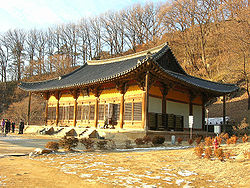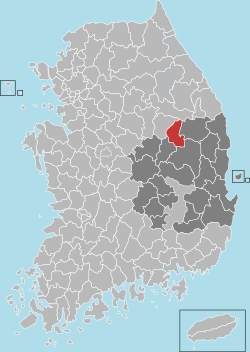Yeongju
|
Yeongju 영주시 |
||
|---|---|---|
| Municipal City | ||
| Korean transcription(s) | ||
| • Hangul | ||
| • Hanja | ||
| • Revised Romanization | Yeongju-si | |
| • McCune-Reischauer | Yŏngju-si | |

Muryangsujeon hall at Buseoksa temple
|
||
|
||
 Location in South Korea |
||
| Country |
|
|
| Region | Yeongnam | |
| Administrative divisions | 1 eup, 9 myeon, 9 dong | |
| Area | ||
| • Total | 668.45 km2 (258.09 sq mi) | |
| Population (2003) | ||
| • Total | 196,000 | |
| • Density | 293.2/km2 (759/sq mi) | |
| • Dialect | Gyeongsang | |
Yeongju (Korean pronunciation: [jʌŋ.dʑu]) is a city in the far north region of North Gyeongsang province in South Korea, covering 668.84 km2 with a population of 113,930 people according to the 2008 census. The city borders Bonghwa county to the east, Danyang county of North Chungcheong province to the west, Andong city and Yecheon county to the south, and Yeongwol county of Gangwon province to the north.
Buseoksa Temple in Yeongju is outstanding as a representative temple of the Avatamsaka Sect of Silla Buddhism. Sosu Seowon is the first Seowon (Confucian academy) to have had national financial support by way of tax exemptions.
Yeongju is also home to a large Novelis Aluminum plant, employing approximately 1000 workers. This plant provides flat-rolled aluminum sheet products to customers throughout Asia.
Yeongju is divided into nineteen primary divisions: nine dong (동/洞) or neighborhood, one eup (읍/邑) or town, and nine myeon (면/面) or township.
The eup and myeon are further divided into numerous ri (리/里) or village.
Buseoksa
Portrati of the Confucian scholar, An Hyang, stored at Sosu Seowon
A pavilion in Tansan-ri, Yeongju
Rock carved Buddha statues in Yeongju
Coordinates: 36°48′21″N 128°37′26″E / 36.80583°N 128.62389°E
...
Wikipedia

